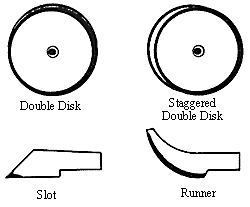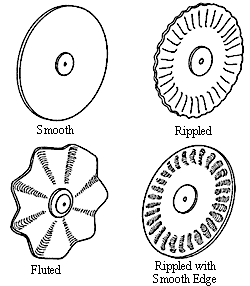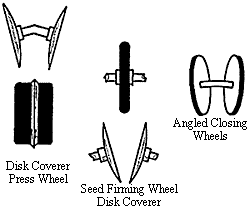Conservation Tillage Planter Equipment
Originally written February 1, 2006 | Last updated February 23, 2014
Many brands of planters can be used for conservation tillage. Many of these do not
require any modification. Planter performance is influenced by planter features
and attachments, as well as proper machine adjustment and operation. While options
are available for adapting planters to a wide variety of soil and residue conditions,
major features are largely dependent on the brand of planter.
Seed Furrow Openersy dependent on the brand of planter.
Seed Furrow Openers

The major function of seed furrow openers is to create a well-defined groove in
the soil where the seed can be placed at the proper depth. Research indicates no
difference in seed spacing uniformity exists among the various openers.
Although a runner can create a cleaner seed furrow, the double-disk opener can cut
through residue and reduce potential clogging problems. The double-disk opener also
has better depth control under conservation tillage conditions because, unlike a
runner, it does not have a tendency to float up and over residue.
The staggered double-disk opener is a modification of the double-disk seed furrow
opener. With this design, the leading edge of one disk is slightly in front of the
other. The leading disk cuts the residue and soil and the trailing disk helps open
the seed furrow.
A variation of a runner opener is a slot shoe opener which slides under the residue
and lifts it out of the seed furrow. The slot shoe opener requires a coulter in
front to avoid clogging problems from residue wrapping around the opener when used
in no-till.
The planter's capability to cut residue depends on the amount and condition
of the residue. For example, planters with disk seed furrow openers can cut fragile
soybean residue and penetrate the mellow soil surface without a coulter, provided
the residue was uniformly spread behind the combine.
On older planters, the disks may need sharpening or adjusting to properly cut the
residue. As the disks wear, a gap develops and allows residue and soil to wedge
between the disks. If this occurs, remove spacer washers behind the disks and adjust
to maintain about two inches of blade contact on the leading edge of the double-disk
seed furrow openers. When properly adjusted and maintained, double-disk seed furrow
openers without coulters also can cut dryland corn or grain sorghum residue, especially
if the stalks were shredded or heavily grazed.
Coulters


More abundant or unevenly distributed residue usually requires coulters in front
of the double-disk seed furrow openers. Runner seed furrow openers also need coulters
to cut residue so the runner doesn't ride up over the residue, causing poor
seed placement and germination. The leading disk of the staggered double-disk seed
furrow opener can act as the coulter. This design can eliminate the need for a coulter
to cut residue, even in heavy residue conditions.
The primary function of a coulter is to cut the residue, not till the soil. The
seed furrow opener performs the tillage necessary for seed-to-soil contact. The
coulter should be operated at slightly less than the seed placement depth. This
prevents loosening soil beneath where the seed will be placed, and avoids forming
air pockets which may dry out the soil.
Smooth, rippled, rippled with a smooth edge or fluted rolling coulters are common
choices to add in front of the planter units to cut residue (Figure 3). In general,
wider ripples or flutes on the coulter increase tillage action, but require more
weight for penetration. As much as 400 to 600 pounds per coulter may be required
for some no-till applications.
To prevent "throwing" excessive amounts of soil or herbicide away from
the row, keep ground speeds below four mph when using fluted coulters. Rippled coulters
perform less tillage with less weight while allowing for higher planter speeds.
Rippled coulters with a smooth edge or smooth coulters are preferred to cutting
residue. Conventional disk rolling equipment can be used to maintain a sharp cutting
edge on these coulters.
Most equipment manufacturers offer coulters as an option. These coulters may be
mounted to the toolbar or the planting unit. Older planters may need an additional
toolbar to mount the coulters on.
Coulter operating depth in relation to seeding depth is more consistent when the
coulter is mounted to the planting unit. Coulters should be mounted close to the
seed furrow openers to avoid tracking errors on slopes and curves.
Row Cleaning Devices

Double-disk furrowers, row cleaners, sweeps or horizontally mounted disks may be
used in front of the planting unit to push clods and residue away from the row.
These devices are necessary in ridge plant systems to remove weed seed from the
ridge top during planting. In addition, these devices have been used in conventional
tillage to remove clods and dry soil from the row to allow planting into moist soil.
Row cleaning attachments are not necessary in most no-till applications, especially
if coulters or double-disk seed furrow openers are used to cut the residue.
Row cleaning devices often are misused when planting, creating a deep furrow, similar
to that of a lister. The main function of row cleaning devices is to remove residue
and weed seed from the soil surface for easy planting and not to till a deep furrow.
Runoff can concentrate in the furrows, washing out seeds and plants and causing
gully erosion. In level fields water may pond in the furrows, causing the soil to
crust, making seedling emergence difficult.
Because of these problems, as well as the cost of row cleaning devices, they may
not be desirable unless the planter is to be used as a ridge-planter. Unfortunately,
when the furrowing devices are used to move residue, clods, or soil, any previously
applied herbicide also may be moved out of the row area, leaving an untreated seedbed.
A band application of herbicide behind the planting unit solves this problem.
Seed Covering

Good seed-to-soil contact is essential for germination and seedling emergence. Depending
on the planter and options selected, a seed covering device, press wheel or a combination
of these are used to provide the necessary seed-to-soil contact. While older planters
relied on the natural tumbling of loose soil to cover the seed, planters used in
conservation tillage must have some method of moving soil back into the seed furrow.
Commonly used seed covering devices include disks and knives. The knife coverer
is less expensive, but may plug in residue covered fields. The disk coverers will
either cut or roll over the residue, reducing plugging problems.
Many planters use press wheels to firm the soil around the seed after it has been
covered (Figure 5). Other planters use a narrow seed firming wheel to firm the seed
into the soil. This firming wheel operates in front of the seed covering device
and presses the seed into the bottom of the furrow, ensuring good seed-to-soil contact.
The remaining planters use closing wheels, often mounted in a V-shaped configuration,
to close the seed furrow and firm the seedbed at the same time.
Currently, there is no combination of covering devices and press wheels that offers
a distinct advantage in the variety of tillage and soil conditions encountered.
The combination of seed covering devices and press wheels selected should cover
the seed with soil, not residue; firm the soil around the seed, but avoid excessive
compaction; and provide a soil surface not vulnerable to crusting after planting.
Soils differ dramatically both in response to conservation tillage and in susceptibility
to soil erosion. Soils which are well drained because of soil texture, depth to
water table and slope perform well under conservation tillage, since they dry and
warm quickly under crop residue. Generally these soils are very susceptible to erosion.
Poorly drained soils, such as those found in depressions, or low-lying level land
conditions, seldom erode but they are difficult to manage regardless of tillage
system.